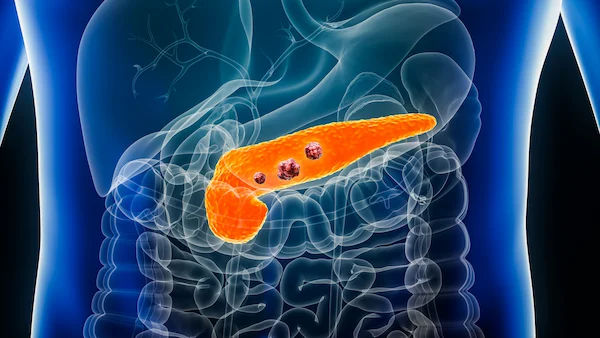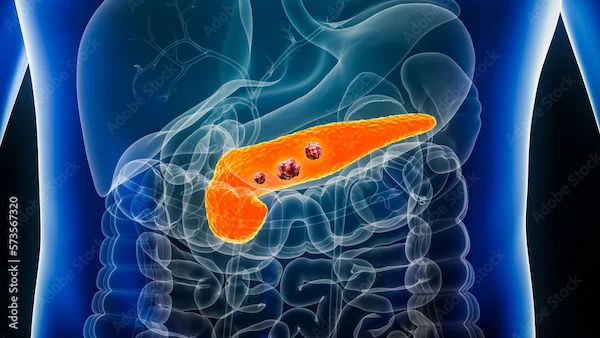Signs Of Pancreatic Cancer Signs
Learn to recognize the early signs of pancreatic cancer. Early detection is crucial, so be aware of symptoms like unexplained weight loss, jaundice, and abdominal pain.


Introduction
Pancreatic cancer is often called a "silent" disease because its early signs can be vague, easily mistaken for more common ailments, or absent altogether. Nestled deep within the abdomen, a tumor can grow for some time before it causes noticeable symptoms, typically by pressing against nearby nerves, organs, or blocking bile ducts. This delayed presentation is a primary reason why pancreatic cancer is frequently diagnosed at a more advanced stage. However, being aware of the potential warning signs is a critical first step in advocating for your health. This article will provide a comprehensive guide to the signs of pancreatic cancer, explaining not just what to look for, but why these symptoms occur. We will cover the most common indicators like jaundice and abdominal pain, as well as less obvious signs such as new-onset diabetes. Our goal is to empower you with knowledge, so you can have informed conversations with your healthcare provider. If you experience persistent symptoms that concern you, consulting a doctor online with Apollo24|7 can be a convenient first step for professional evaluation.
The Most Common Signs and Symptoms of Pancreatic Cancer
While symptoms can vary based on the tumor's size, type, and location within the pancreas, several key signs are frequently associated with this disease. Recognizing these patterns is crucial.
Jaundice: The Yellow Warning Sign
Jaundice is one of the most recognizable signs of pancreatic cancer, particularly when a tumor is located in the head of the pancreas, near the common bile duct. It occurs when a tumor blocks the bile duct, causing a buildup of bilirubin—a yellow pigment produced by the liver—in the bloodstream. This leads to:
Yellowing of the skin and the whites of the eyes.
Dark brown urine, often described as tea-colored.
Pale, clay-colored stools because bilirubin can't reach the intestines.
Jaundice is often one of the first signs to appear for tumors in the pancreatic head and is a clear indicator that medical attention is needed.
Consult Top Specialists
Itchy Skin (Pruritus): A Distressing Side Effect of Jaundice
Many people with jaundice also experience intense, widespread itching. This is directly caused by the accumulation of bilirubin salts in the skin. The itching can be severe enough to disrupt sleep and daily life, and it often persists until the bile duct obstruction is relieved.
Abdominal and Back Pain: A Deeper Ache
Pain in the abdomen or mid-back is a common symptom. Unlike a sharp, fleeting pain, what does pancreatic cancer pain feel like? It's often described as a dull, persistent ache that may radiate from the upper abdomen to the back. This happens as the tumor grows and presses against nerves and organs surrounding the pancreas. The pain might worsen after eating or when lying down and may be somewhat relieved by leaning forward. Understanding the specific nature and location of this discomfort is key to distinguishing it from common back pain or indigestion.
Unexplained Weight Loss and Appetite Changes
Significant, unintentional weight loss is a red flag for many cancers, including pancreatic cancer. This occurs for two main reasons:
1. The cancer itself consumes a lot of the body's energy.
2. The pancreas plays a vital role in digestion. A tumor can disrupt the production of pancreatic enzymes, leading to poor absorption of nutrients from food (malabsorption). This can cause you to feel full quickly or experience a loss of appetite, even if you aren't eating much.
Digestive Issues: Nausea and Changes in Stool
When a tumor blocks the release of digestive enzymes into the small intestine, it can lead to inefficient digestion, causing nausea, vomiting, and indigestion that doesn't improve with typical antacids. Furthermore, the inability to digest fats properly can lead to steatorrhea—fatty, foul-smelling stools that are loose, float, and are difficult to flush. This is a direct result of the malabsorption caused by the lack of pancreatic enzymes.
Less Common but Significant Warning Signs
Beyond the primary symptoms, other signs can also point toward pancreatic cancer and should not be ignored, especially if they occur in combination.
New-Onset Diabetes in Adults
While diabetes is common, developing it suddenly after the age of 50 with no other risk factors (like obesity) can be a warning sign. The pancreas produces insulin, and a tumor can impair its ability to do so, leading to insulin resistance or diabetes. If you are diagnosed with diabetes and also experience weight loss or abdominal pain, it's important to discuss this fully with your doctor.
Blood Clots (Thrombosis)
Pancreatic cancer can increase the risk of developing blood clots, often in large veins like those in the leg (deep vein thrombosis or DVT). A clot can cause swelling, pain, and redness in the affected limb. Sometimes, a clot can travel to the lungs (pulmonary embolism), causing chest pain and breathing difficulties. The presence of an unexplained blood clot can sometimes be the first sign of an underlying cancer.
Fatigue and General Malaise
This is more than just feeling tired. Cancer-related fatigue is a profound sense of exhaustion that isn't relieved by rest. It can be caused by the body fighting the disease, nutritional deficiencies from malabsorption, or anemia. While fatigue is a nonspecific symptom, when coupled with other signs on this list, it contributes to a larger picture.
Why Are Pancreatic Cancer Symptoms Often Missed?
The challenge with early warning signs of pancreatic cancer lies in their mimicry of everyday health issues. Indigestion, back pain, and appetite changes are far more likely to be caused by benign conditions. Furthermore, in its early stages, the pancreas has a large functional reserve, meaning a small tumor may not impair its function enough to cause symptoms. By the time symptoms like jaundice or significant pain appear, the tumor may have grown substantially or spread. This underscores the importance of paying attention to persistent or clusters of symptoms.
When Should You Be Concerned? A Guide to Action
It's important not to panic, as most people with these symptoms do not have pancreatic cancer. However, you should be proactive if you experience:
Jaundice (yellowing skin/eyes).
Abdominal or back pain that is new, persistent, and doesn't have a clear cause.
Unexplained weight loss of 5% or more of your body weight over 6-12 months.
Significant digestive changes that last more than a few weeks.
If symptoms persist beyond two weeks, consult a doctor online with Apollo24|7 for further evaluation. They can review your symptoms, medical history, and recommend the next steps, which may include diagnostic tests.
Diagnosis: Steps Your Doctor May Take
If pancreatic cancer is suspected, your doctor will typically start with a physical exam (checking for abdominal masses or signs of jaundice) and a review of your medical history. They may then order:
1. Imaging Tests: A CT scan, MRI, or endoscopic ultrasound (EUS) can provide detailed images of the pancreas and help identify tumors.
2. Blood Tests: While there is no single definitive blood test, a test for the tumor marker CA 19-9 can provide information. Elevated levels can be associated with pancreatic cancer, but they can also be raised in other conditions.
3. Biopsy: The only way to confirm a cancer diagnosis is by examining a small tissue sample under a microscope. This is often done during an EUS procedure.
Quick Takeaways:
Jaundice (yellow skin/eyes, dark urine, pale stools) is a major red flag.
Persistent abdominal or back pain that feels deep and aching warrants investigation.
Unexplained weight loss and loss of appetite are significant symptoms.
New-onset diabetes in adulthood, especially with weight loss, can be a sign.
Digestive issues like nausea and fatty stools that don't resolve need attention.
Symptoms are often vague; it's the persistence and combination that matter most.
Early detection is challenging but critical. Advocate for yourself and seek medical advice concerning symptoms.
Conclusion: Empowerment Through Awareness
Understanding the signs of pancreatic cancer is a powerful tool in the fight against this disease. While its "silent" nature presents a challenge, knowledge dispels fear and enables proactive health management. Remember, most of these symptoms are caused by conditions far less serious than cancer. However, ignoring persistent changes in your body can have consequences. The key is to listen to your body, recognize when a cluster of symptoms is unusual for you, and take action by consulting a healthcare professional. Timely evaluation can lead to an accurate diagnosis, whether it's pancreatic cancer or another issue, and open the door to the most effective treatment options available. If your condition does not improve after trying basic methods for common ailments, booking a physical visit to a doctor with Apollo24|7 ensures you get a comprehensive, in-person assessment.
Consult Top Specialists
Consult Top Specialists

Dr. Rajib Ghose
General Physician/ Internal Medicine Specialist
25 Years • MBBS
East Midnapore
VIVEKANANDA SEBA SADAN, East Midnapore

Dr. Arif Ahmed
General Physician/ Internal Medicine Specialist
9 Years • MBBS, MD (Genl. Med.)
Kolkata
MCR SUPER SPECIALITY POLY CLINIC & PATHOLOGY, Kolkata

Dr. Utsa Basu
Diabetologist
14 Years • MBBS , MD
Barasat
Diab-Eat-Ease, Barasat
(75+ Patients)

Dr. Sougata Kumar
General Practitioner
8 Years • MBBS
East Midnapore
VIVEKANANDA SEBA SADAN, East Midnapore

Dr. Abhishek Ranjan
General Practitioner
4 Years • MBBS
Kolkata
VDC Clinic, Kolkata


.webp)

.webp)